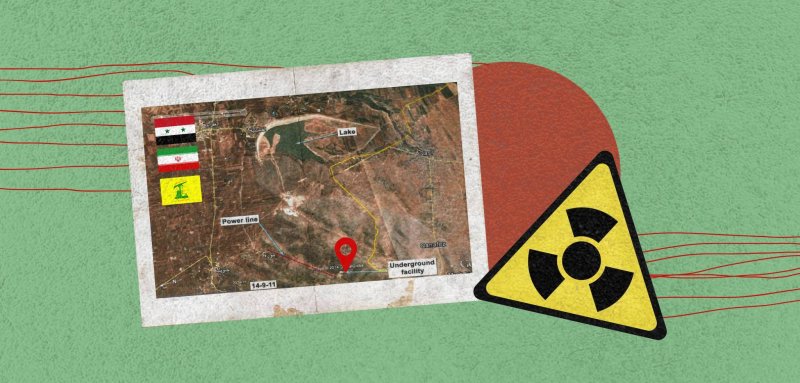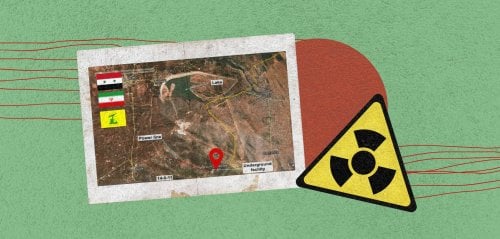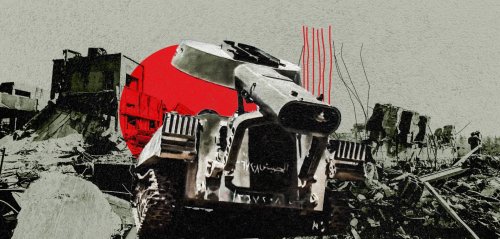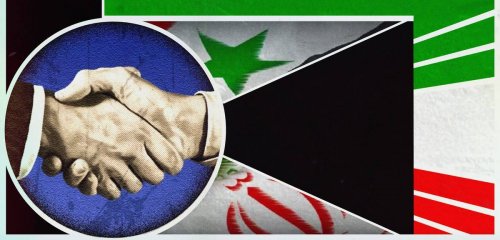"In al-Qusayr, there is an underground military facility that may be related to nuclear activities." With this statement, the Institute for Science and International Security began its latest report on what is happening in the Syrian city of al-Qusayr, near the Syrian-Lebanese border. It points out that "the facility is suspected to have three tunnel entrances concealed by buildings and maintains a low security profile with only a single observable checkpoint, which is usually done to camouflage similar activities, in a similar case to the low-security system of the al-Kibar facility in Deir ez-Zor, which was destroyed by Israel in 2007."
While the true purpose of the site is uncertain, according to the institute, "the military or even nuclear-related objective of the facility remains a possibility" within the interpretation of the ongoing excavation and other operations there, which "poses a major engineering challenge and requires extensive foreign assistance."
The Institute for Science and International Security is a nonprofit, non-governmental organization founded in 1993, and based in Washington. It is headed by nuclear inspector David Albright, the former director of the International Atomic Energy Agency (IAEA). It is concerned with informing the public about scientific and policy issues that affect international security. Due to its effectiveness, it consistently maintains its classification as one of the top 25 intellectual institutions for science and technology in the world. In 2015, it was ranked as one of the best think tanks in the United States and in foreign policy in the world.
Earlier, in 2015, Der Spiegel published an article based on secret information it obtained, indicating that "Syria's dictator (Bashar al-Assad) has not given up his dream of an atomic weapon and has apparently built a new nuclear facility at a secret location," adding that "the world is once again being misled by Assad."
One of the reasons it drew attention is the effort being made to conceal the digging, which is usually easily detected in satellite images
One of the reasons that has caught the attention of the Institute for Science and International Security is the effort being made to conceal the digging, which is usually easily spotted in satellite images. But in al-Qusayr, the mounds of soil have been camouflaged, and tunnel entrances have been hidden by buildings located at the foot of the mountain. In addition, there was mobile drilling activity on-site, and the hydrological maps of the area showed a large groundwater layer close to the surface, which could possibly provide water for cooling the underground facility. The supporting infrastructure includes a deep well at the site connected to Lake Zita, four kilometers away, which is a requirement for nuclear facilities, not military ones, according to Der Spiegel. While it is not possible to confirm the existence of 8,000 nuclear fuel rods at the site, it remains a concerning possibility.
After the death of one of its members in Syria in October 2012, Hezbollah had initially admitted to its involvement in a limited operation with Assad's forces to defend 23 villages around al-Qusayr. On May 19, 2013, it launched a wide-scale attack that lasted for 20 days, during which it took control of the area, leading to the displacement of most of its residents. During the battle, Hezbollah Secretary-General Hassan Nasrallah hinted at a longer stay in the "Syrian war", stating that it was no longer about "a people participating in a revolution against the regime or a matter of reforms, but rather a existential threat to Lebanon as a whole, not just Hezbollah and the Shia population in Lebanon, and its intervention is to protect the country's interests."
The Zamzam Facility
Syria possesses up to 50 tons of natural uranium, which was transferred to a hidden underground site west of al-Qusayr city after the Syrian revolution entered the armed conflict phase, according to intelligence estimates reported by the German magazine. It was based on intercepted communications, the most evident of which was radio traffic, through which a high-ranking official in Hezbollah referred to an "atomic factory" in al-Qusayr, mostly referred to as the "Zamzam Facility", while providing repeated updates via phone to the head of Syria's Atomic Energy Commission, Ibrahim Othman. Since then, the al-Qusayr facility, which was previously overlooked, has come under expert scrutiny.
One of the city's residents (who asked that his identity not be disclosed) refers to the "project's age, dating back nearly two decades." He indicates direct Iranian supervision over it, saying, "It was being promoted as a center for scientific research, but the circumstances that accompanied the project have raised many doubts, such as regular power cuts on Mondays and Wednesdays, the disruption of communications coinciding with convoys entering the area accompanied by forces from the Republican Guard present in the area for military security, the existence of drills and tunnels, including a large tunnel connecting the Wadi Hanna area in Syria to the Qasr area in Lebanon, as well as the neglect of the area, which is an archaeological and touristic site, in order to keep tourists away. We were also subjected to meddlesome inquiries about our guests from other Syrian cities. Even if the guest was not Syrian, he and his host could disappear into the unknown," recalling the incident of a shepherd being accidentally killed near the facility.
While it had been promoted as a center for scientific research, the circumstances surrounding the project raised many doubts, including routine power cuts on Mondays and Wednesdays, and disruption of communications coinciding with convoys entering the area
In his conversation with Raseef22, the young man rules out the possibility of nuclear activity at the facility, especially based on the hypothesis of using Lake Zita to cool the reactor. The construction of the dam behind the lake was intended to cover up the movement of heavy machinery in the area, suggesting a connection between the facility and the manufacturing and storage of weapons, which are then transported via tunnels to Hezbollah. He also pointed to a malicious operation to displace the residents of the area, through sectarian friction and stirring up unrest to strike the social components there, accompanied by a process of land purchase by the Iranians. He concluded his statement by saying, "Since the rebels took control of Tell Mando, which leaves the area exposed to them, Hezbollah hastened to launch a bloody battle to control the region."
Previously, the site was considered a facility for storing conventional weapons for Hezbollah. However, after Der Spiegel spoke of it possibly being a nuclear facility, the institute began assessing it. But the lack of further information about power supplies, the alleged connection to the lake or groundwater supplies, water withdrawal and drainage systems, a ventilation system, security measures, and the underground facility's size, together with field information from defectors or international inspectors, do not allow for any definitive conclusion regarding possible nuclear activities at the site.
The hypothesis of a nuclear facility is not excluded by Major General Majid al-Qaisi, the Director of the Security and Defense Program at the Policy-Making Center, but he also does not consider it likely. He points out that "the area came under the control of opposition factions opposing the Assad regime early on, and if there were a nuclear facility, these factions, some of which belong to extremist groups, would have been aware of it. Additionally, its proximity to the Lebanese border allows for Western and Israeli intelligence to detect it, especially considering the immense funds required for nuclear projects, which the besieged Assad regime lacks."
Speaking to Raseef22, he adds, "The construction of the facility may have begun to turn into that of a nuclear facility after the Israeli air force bombed the al-Kibar site in eastern Syria in 2007. However, what happened inside Syria, with the revolution that later turned into an armed conflict, halted this project. During the intense battles that took place in most areas of Syria from late 2012 to 2015, the nuclear fuel rods, previously moved by the Assad government from the al-Kibar site, were transferred to the al-Qusayr site after Hezbollah gained firm control over the city, securing them there only for storage within the buildings and underground tunnels, not for enrichment purposes. In my estimation, the facility may have been transformed for military purposes, but not for nuclear purposes, although I do not rule out its nuclear origin."
Born nuclear, a lack of funds turned it military
In March 2018, the Institute for Science and Security analyzed the al-Qusayr facility in a report for the first time, following the Der Spiegel report, and followed it with several other reports, the latest in April. It reviewed the processes used in cooling nuclear facilities, concluding that water wells could potentially cool the reactor in locations where surface water is not accessible, but further scrutiny and examination of the site is necessary to reach a final conclusion, as other factors such as suitable infrastructure and hydrogeological conditions leading to groundwater flow may not be clear.
During an intensive four-hour Israeli attack against Iranian sites in Syria in May 2018, the city of al-Qusayr was one of the targets
According to photographer and journalist Jaafar Mohib al-Din, who is from the region, "Large trucks carrying massive equipment entered the area. I saw them, but couldn't discern their contents, like many others who witnessed them. However, they are not weapons. They are larger in size and have nothing to do with the Zita Dam project; they are for the preparation of a major project."
He further adds in his conversation with Raseef22, "The passing of the trucks through al-Qusayr heading west towards the border took place at night, and was accompanied by power outages in the entire area. These trucks were accompanied by pickup trucks without license plates." He also mentioned the discovery of the ancient Zita Cave during the excavation process for the dam, which is a cave of great historical and archaeological significance, similar to the Jeita Cave in Lebanon. However, the excavations did not stop as required by laws meant to protect cultural heritage, especially considering the futility of the dam project and the damages it caused to agricultural lands and groundwater in the area, indicating that the dam is a facade for something else.
During an intensive four-hour Israeli attack against Iranian sites in Syria in May 2018, the city of al-Qusayr was one of the targets, according to the Times of Israel.
In its report issued in September 2018, the institute opposes the notion of the sensitivity of the site based on its destruction by Israel. However, there is a risk in its destruction, due to the possible presence of nuclear materials inside. Without Israel's transparency in explaining its objectives, it becomes increasingly difficult to determine the true purpose of the site, whether it is nuclear, military, or otherwise. The facility could serve military purposes, and a fully underground nuclear reactor is not impossible, according to the March 2018 report. However, it poses a significant engineering challenge and requires secret and continuous assistance from North Korea. Similarly, the enrichment facility would require large-scale foreign assistance, likely from North Korea or perhaps Iran.
According to the Washington Institute for Near East Policy, North Korea built a nuclear reactor in Syria's Deir ez-Zor Province, known as "Al-Kibar," which was a near-replica of North Korea's Yongbyon reactor used for producing plutonium for its nuclear arsenal.
UN investigators also uncovered supplies that had been smuggled from North Korea to the Syrian Scientific Studies and Research Center, which is the secret body overseeing Bashar al-Assad's chemical weapons program. Korean expert Cho Jae-boo, who contributed to the construction of al-Kibar, disappeared for a long time, during which he was believed to have fallen victim to internal elimination in Korea. Western intelligence agencies currently suspect he went to Syria to work underground.
Few signals, a great deal of analysis
In a report in 2013, Newsweek Japan refers to deepening Iranian-North Korean relations through nuclear tests and repeated participation of Iranian scientists responsible for developing nuclear warheads that can be loaded onto ballistic missiles. This includes Mohsen Fakhrizadeh's visit to North Korea to attend the third nuclear test.
According to Major General al-Qaisi, "Nuclear activity has not escaped the world's attention throughout these years, especially in light of the extensive Western security breaches in the Syrian arena after it slid into armed conflict. It also needs assistance and guidance in the nuclear field, which North Korea and Iran could provide in a stable situation. As mentioned above, the facility may have been prepared to be a nuclear facility, but later transformed into a factory or warehouse for storing missiles and drones belonging to Hezbollah, alongside secured nuclear fuel rods at the site, given its immunity."
The infrastructure may have been initially prepared to be a nuclear facility, but it later transformed into a factory or storage facility for storing missiles and drones belonging to Hezbollah, alongside nuclear fuel rods secured at the site
When it comes to the hypothesis of a nuclear facility and uranium enrichment, it contradicts Syria's economic reality, according to al-Qaisi. He states, "Each of these facilities requires 6-8 associated manufacturing plants, including cable manufacturing, the production of massive cement molds for specific protection measures, manufacturing plants for centrifuge rotor bars that require specific heat-resistant metals, as well as the generation of high-power electricity, expensive and heavy drilling equipment, and stations to cool the reactor core, which can be cooled with water but requires advanced technology. Considering the country is under siege and bombardment, the process is complex and, if not impossible, extremely difficult."
A local resident, who identified himself as "Abu Al-Muthanna" (pseudonym), told Raseef22 about the camouflage and deception of satellites being conducted through the existence of 'fake' projects that require heavy movement of vehicles and machinery. These projects include the unsuccessful economic feasibility of the Zita Dam and the Jusiyah Agricultural Scientific Research Center, also known as the "Hawash" center, named after the engineer who executed the project.
He refers to some "sensitive points, such as strict surveillance and significant security pressure in the region, which has not been witnessed in any other border area, and the replacement of security border agents above the Assi (Orontes) River with new operatives coming from Damascus. Their focus was not primarily on preventing smuggling, but on verifying the identities of individuals, especially strangers to the area, to learn about their backgrounds and the reason for their presence in the region." He recalls the rumors circulating at that time about Western movement in the area as an arms transfer operation for Hezbollah in support of its resistance against Israel.
The New York Times had previously mentioned a 200-page United Nations report that explained how North Korea is avoiding sanctions and sending components to Syria for the production of chemical weapons. This report came at a time when the White House had accused Syria of using chlorine gas.
In an interview with Assad in 2009, Der Spiegel quoted him as saying, "Syria is fundamentally opposed to the proliferation of nuclear weapons. We want a nuclear-free Middle East, Israel included." However, the reality contradicts his statement, considering the use of chlorine gas after 2013, the year in which Assad reached an agreement to surrender Syria's chemical stockpile. This agreement was mediated by Russia in an attempt to prevent a possible American strike against its ally, following his alleged use of chemical weapons against opposing factions that summer.
Raseef22 is a not for profit entity. Our focus is on quality journalism. Every contribution to the NasRaseef membership goes directly towards journalism production. We stand independent, not accepting corporate sponsorships, sponsored content or political funding.
Support our mission to keep Raseef22 available to all readers by clicking here!
Interested in writing with us? Check our pitch process here!





